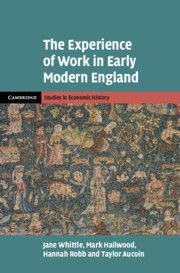Tables
The data in all tables should be assumed to be unfiltered (by information status) and unadjusted (by the female multiplier) unless otherwise stated in the table ‘notes’.
1.1Social/occupational status of male deponents in the dataset
1.6Gender division of labour by category, female multiplier applied
2.10Social/occupational status of male actors in the dataset
2.14Sectoral distribution of ‘for another’ tasks excluding carework and housework
2.17Proportion of types of work performed by male occupational groups
2.19Largest subcategories (25+ tasks) for labourers, husbandmen, and male servants
2.21Proportion of work tasks ‘for another’ by occupation (male)
3.4Rural and urban work repertoires by task location and worker residence
3.5Women’s rural and urban work repertoires compared, by residence of worker
4.2Gender division of seasonal work: top categories and subcategories by quarter
4.3Agricultural and craft occupations (male): top two categories and task distribution per quarter
4.4Sabbath work: comparing weekday repertoires and gender division of labour
4.5Workdays vs holy days: comparing repertoires and gender division of labour
6.10Gender division of labour in collecting fuel and gathering food
7.1Work repertoires of male servants and apprentices compared
7.3Gender division of labour and location of textile production
7.4Gender division of labour and location of clothing and shoemaking
8.3Gender division of labour in commerce and finance comparing creditors and debtors
